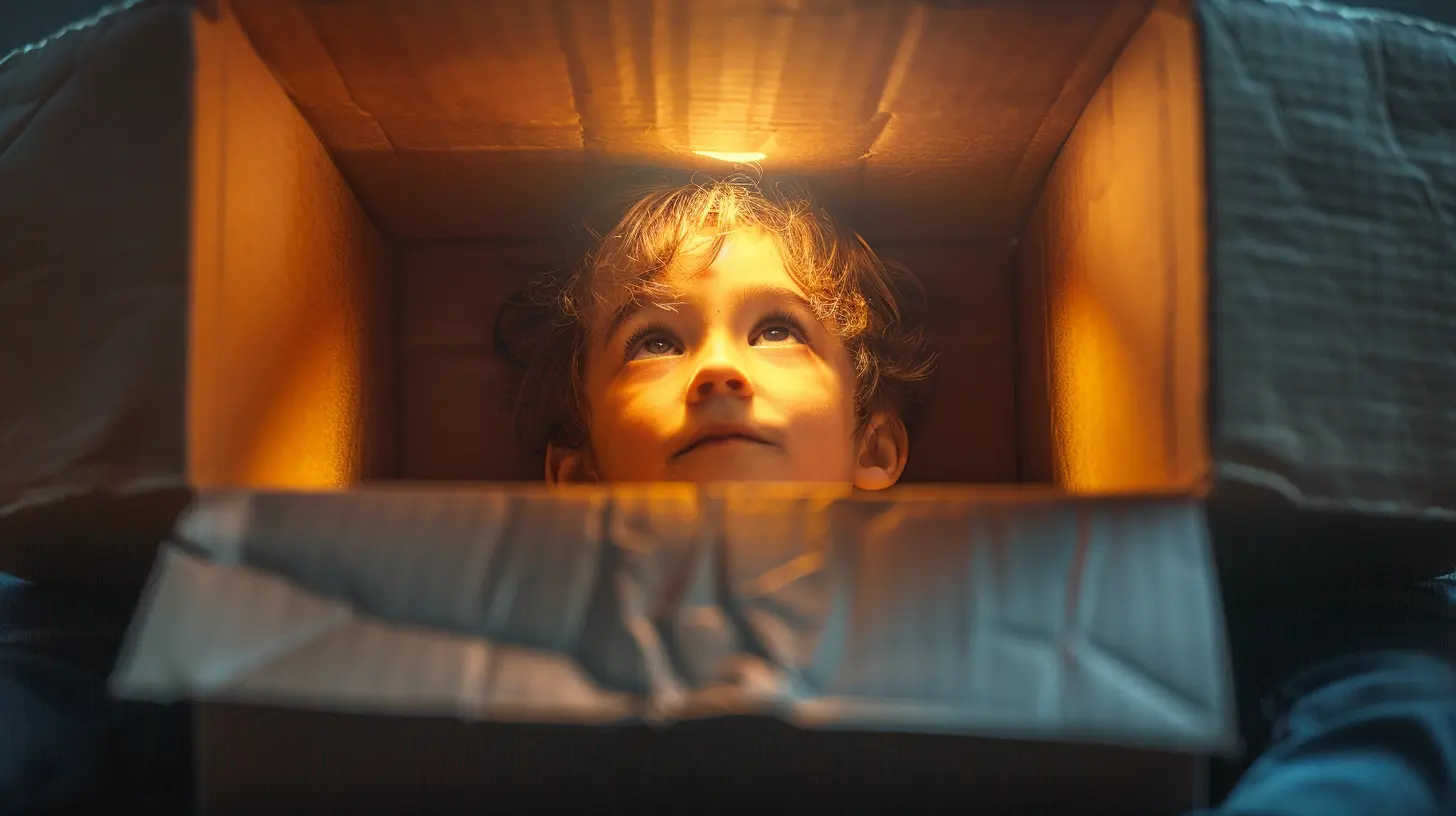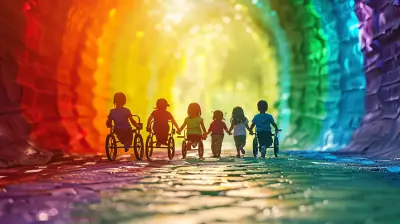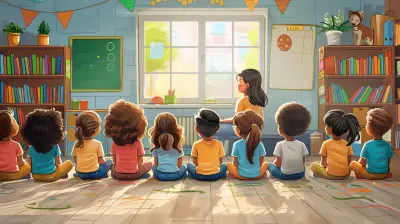Empowering Students to Think Outside the Box
5 December 2024
In today’s fast-paced world, the ability to think outside the box is no longer a luxury—it’s a necessity. Whether it’s solving complex problems, fostering creativity, or simply adapting to the ever-changing landscape of modern life, students who can think independently and creatively will stand out in almost every field.
But what does it actually mean to "think outside the box"? And more importantly, how can we empower students to develop this essential skill? In this article, we’ll explore the importance of fostering creative and critical thinking in education, practical ways educators and parents can nurture these skills, and why it's so crucial for the success of future generations.
What Does It Mean to Think Outside the Box?
Before we dive into how to empower students, let’s clarify what it means to think outside the box. Simply put, it’s the ability to approach problems in a way that is unconventional, innovative, and often unexpected. It’s about breaking free from traditional or established thought patterns and finding new, creative solutions.Imagine a maze. Most people will try to follow the paths laid out for them, carefully navigating dead ends and wrong turns. But someone who thinks outside the box might ask, “Why not just climb over the walls or find a way to fly above the maze?” It’s this kind of creative problem-solving that can drive innovation and success in any field—from science and engineering to arts and entrepreneurship.
Why Is Thinking Outside the Box So Important?
In a world that's constantly evolving, the ability to think differently is crucial. Technology is advancing at an unprecedented rate, industries are being disrupted, and job markets are shifting in ways we can’t always predict. The jobs of tomorrow might not even exist today. So, how do we prepare students for a future that’s uncertain? The answer lies in helping them develop a mindset that is adaptable, creative, and resilient.Take some of the most successful innovators in recent history—Elon Musk, Steve Jobs, or Malala Yousafzai. What do they all have in common? They didn’t just follow the usual script. They challenged conventional thinking, questioned the status quo, and found novel solutions to problems that many believed were impossible to solve.
By empowering students to think outside the box, we’re not just preparing them for academic success; we’re equipping them with the tools they need to navigate life’s challenges, take risks, and drive meaningful change in the world.
The Barriers to Creative Thinking in Education
Unfortunately, many traditional education systems are not designed to foster creativity and independent thinking. Instead, they often prioritize rote memorization, standardized testing, and rigid curriculums that leave little room for exploration or experimentation.Here are a few barriers that can stifle students' ability to think creatively:
1. Fear of Failure
Many students are conditioned to believe that failure is something to be avoided at all costs. But failure is a natural part of the learning process. By focusing too much on “getting it right,” students may shy away from taking risks or trying new approaches.2. Overemphasis on Standardized Testing
In many educational systems, standardized testing is seen as the ultimate measure of success. While tests have their place, they often prioritize memorization over critical thinking. As a result, students may focus more on regurgitating facts than on developing their own ideas.3. Structured Learning Environments
Traditional classrooms are often highly structured, with little flexibility for students to explore their own interests or think freely. This can limit creativity and discourage independent thought.4. Lack of Real-World Application
Many students struggle to see how what they’re learning applies to the real world. When education feels disconnected from real-life experiences, it can be difficult for students to think creatively or see the bigger picture.
How Can We Empower Students to Think Outside the Box?
So, how do we break free from these barriers? How do we create an environment that encourages students to think creatively, challenge assumptions, and develop the confidence to pursue their own ideas? Here are some practical strategies:1. Encourage Curiosity and Questioning
At the heart of creative thinking is curiosity—the desire to explore new ideas, ask questions, and seek out answers. One of the best ways to foster this in students is by encouraging them to ask "why" and "how" questions. Instead of simply giving answers, challenge students to dig deeper and think critically about the world around them.For example, if a student asks, “Why do plants need sunlight to grow?” instead of offering a straightforward answer, you might respond with, “That’s a great question. What do you think? How could we experiment to find out?” This approach not only fosters curiosity but also encourages students to become active participants in their learning process.
2. Promote a Growth Mindset
A growth mindset is the belief that abilities and intelligence can be developed through effort and learning. When students understand that failure is a part of growth, they are more likely to take risks and think creatively. Encourage students to view setbacks as opportunities for learning rather than as a reflection of their abilities.A great way to promote a growth mindset is by praising effort, perseverance, and problem-solving rather than just focusing on results. Statements like “I’m proud of how hard you worked on that” or “It’s great that you didn’t give up” can go a long way in building resilience and creative confidence.
3. Incorporate Project-Based Learning
Project-based learning (PBL) is a teaching method in which students learn by actively engaging in real-world and personally meaningful projects. PBL encourages students to think critically and creatively as they tackle complex problems, collaborate with peers, and apply their knowledge to real-world situations.For instance, instead of simply studying environmental science from a textbook, students might be tasked with developing a sustainable solution for a local environmental issue. This hands-on approach not only makes learning more relevant but also encourages students to think outside the box as they apply their knowledge in practical ways.
4. Create a Safe Space for Risk-Taking
One of the biggest obstacles to creative thinking is the fear of being wrong or making mistakes. To combat this, it’s important to create a classroom environment where students feel safe taking risks and trying new things without fear of judgment.Teachers can do this by fostering a culture of collaboration rather than competition. Encourage students to share their ideas, brainstorm together, and provide constructive feedback to one another. Celebrate creative thinking, even when it doesn’t lead to the “right” answer.
5. Integrate Arts and Creativity into the Curriculum
The arts—whether it's music, drama, visual arts, or creative writing—play a crucial role in fostering innovation and creative problem-solving skills. When students engage in artistic activities, they’re allowed to explore different perspectives, experiment with ideas, and express themselves in new and imaginative ways.Incorporating the arts into the curriculum not only nurtures creativity but also helps students develop empathy, emotional intelligence, and a deeper understanding of the human experience.
6. Use Open-Ended Questions and Problems
Open-ended questions and problems that don’t have a single right answer encourage students to think critically and creatively. These types of questions push students to explore multiple possibilities and think about problems from different angles. For example, instead of asking, “What’s the capital of France?” you might ask, “How would you design a city to solve traffic congestion?” This type of question encourages students to engage in deeper thinking and come up with innovative solutions.
The Role of Technology in Fostering Creative Thinking
In the digital age, technology offers countless opportunities to foster creative thinking in students. From coding and digital design to virtual reality and online collaboration tools, technology can help students explore new ideas, experiment with different solutions, and connect with others in ways that were once unimaginable.1. Coding and Programming
Learning to code is like learning a new language—one that empowers students to create, innovate, and solve problems. Coding encourages logical thinking, problem-solving, and creativity as students design their own programs or apps.2. Online Collaboration Tools
Tools like Google Docs, Slack, and Trello allow students to collaborate on projects, share ideas, and work together in real-time. These platforms encourage teamwork and creative problem-solving as students learn to communicate and brainstorm effectively.3. Virtual Reality (VR) and Augmented Reality (AR)
VR and AR technology offer immersive learning experiences that can spark creativity and curiosity. Imagine students exploring ancient civilizations through virtual field trips or designing futuristic cities using AR. This technology can bring learning to life in ways that are both engaging and innovative.Conclusion: Empowering the Next Generation of Thinkers
Empowering students to think outside the box isn’t just about teaching them to be creative—it’s about giving them the confidence to challenge assumptions, take risks, and pursue their own ideas. In a world where change is the only constant, these skills are becoming more essential than ever.By fostering curiosity, promoting a growth mindset, encouraging risk-taking, and integrating creativity into the curriculum, we can help students develop the skills they need to thrive—not just in school, but in life.
So, let’s break down those walls, climb over the maze, and empower the next generation of thinkers and innovators. The future depends on it.
all images in this post were generated using AI tools
Category:
Creativity In EducationAuthor:

Fiona McFarlin
Discussion
rate this article
18 comments
Echo McDonald
Thinking outside the box? I can barely find it!
February 3, 2025 at 11:36 AM

Fiona McFarlin
I appreciate your humor! Finding that box is the first step to breaking free from it. Let's explore together!
Solara Young
Thinking outside the box? More like thinking outside the classroom! Let’s just hope the students don't mistake the school janitor’s closet for a new creative space. Revolutionizing education, one quirky idea at a time!
January 31, 2025 at 3:54 AM

Fiona McFarlin
Haha, great point! Embracing creativity can lead to unexpected places—let's ensure our innovative spaces remain safe and productive!
Daniel Walker
Absolutely love this! Encouraging students to think outside the box not only sparks creativity but also builds confidence. It's amazing how a little freedom in thought can lead to innovative solutions and lifelong skills. Let's inspire the next generation!
January 25, 2025 at 3:49 AM

Fiona McFarlin
Thank you! I'm glad you resonate with the idea. Inspiring creativity and confidence in students is crucial for their growth and innovation!
Ursula Schultz
In a world where conformity reigns, unlocking the mysteries of innovative thinking becomes paramount. Dare to journey beyond the conventional—what hidden possibilities await when students are encouraged to explore the uncharted realms of their imagination?
January 20, 2025 at 8:13 PM

Fiona McFarlin
Absolutely! Encouraging students to explore beyond conventions not only fosters creativity but also unlocks their potential to innovate and solve real-world challenges. Let's inspire their imaginations!
Rhea Hughes
Love this! Encouraging creativity in students is so important—let's inspire them to explore and innovate fearlessly!
January 16, 2025 at 7:28 PM

Fiona McFarlin
Thank you! Encouraging creativity is vital for fostering innovation and confidence in our students. Let's keep inspiring them!
Kalani Wagner
Why think outside the box? Let's build a spaceship!
January 14, 2025 at 3:35 AM

Fiona McFarlin
Building a spaceship embodies thinking outside the box! It’s about inspiring creativity and innovation in all fields.
Riven Romero
Creativity blooms when boundaries fade—let minds roam free!
January 6, 2025 at 7:51 PM

Fiona McFarlin
Absolutely! Encouraging freedom in thought is key to unlocking creativity and innovative ideas.
Rachael McKittrick
Encouraging creativity fosters critical thinking and problem-solving.
January 3, 2025 at 7:26 PM

Fiona McFarlin
Absolutely! Encouraging creativity not only enhances critical thinking but also equips students with essential problem-solving skills, enabling them to navigate challenges effectively.
Berenice Perez
Empowering students to think outside the box is crucial for fostering creativity and problem-solving skills. Encouraging diverse perspectives in learning environments will lead to innovative thinkers ready for real-world challenges.
January 1, 2025 at 6:04 AM

Fiona McFarlin
Thank you for your insightful comment! I completely agree that fostering diverse perspectives is key to developing creative and innovative thinkers.
Ximena Wilcox
What a fantastic article! Encouraging creative thinking in students is so important for their growth. Let's nurture their curiosity and empower them to explore new ideas and perspectives!
December 28, 2024 at 4:37 AM

Fiona McFarlin
Thank you! I completely agree—nurturing curiosity is key to fostering innovative thinkers!
Heath McAndrews
Imagine teaching students to juggle not just ideas, but also spaghetti! Let’s toss those traditional limits and see what delightful mess we create. Empowering students to think outside the box is like giving them a rainbow of possibilities and a sprinkle of glitter!
December 24, 2024 at 1:02 PM

Fiona McFarlin
Absolutely! Embracing creativity, even in unconventional ways, inspires students to explore limitless possibilities and fosters a vibrant learning environment. Let’s keep the ideas—and spaghetti—flowing!
Riff Spencer
Innovative thinking fosters creativity.
December 14, 2024 at 1:09 PM

Fiona McFarlin
Absolutely! Innovative thinking is essential for unlocking creativity and empowering students to explore new ideas.
Ivan McTier
Empowering students to think outside the box fosters creativity and resilience, essential skills for navigating an ever-changing world and solving complex problems.
December 12, 2024 at 3:53 AM

Fiona McFarlin
Thank you! I completely agree—fostering creativity and resilience in students is crucial for their success in an unpredictable world.
Laura Rosales
Thinking outside the box is great, but let’s not forget: sometimes it's just as important to ensure students can find the box first! After all, how will they know when they’ve creatively broken free? Here’s to crafting thinkers who can build and dismantle with equal flair!
December 10, 2024 at 9:11 PM

Fiona McFarlin
Absolutely! Understanding the foundational concepts is crucial for true innovation. Thanks for highlighting the importance of both skills!
Orion Rogers
Oh sure, because asking students to think outside the box is *totally* a revolutionary concept! Next, let’s empower them to breathe air and drink water. Who knew education could be so groundbreaking? Can’t wait for the next big idea: learning to tie their shoes!
December 6, 2024 at 5:32 AM

Fiona McFarlin
I appreciate your humor! While thinking outside the box might seem basic, fostering critical thinking skills is essential for innovation and problem-solving in today's world.
Simone Roth
Great insights! Encouraging creative thinking in students is essential for their growth and problem-solving skills.
December 5, 2024 at 9:24 PM

Fiona McFarlin
Thank you! I completely agree—fostering creative thinking is key to helping students thrive and tackle challenges effectively.
Spike Harper
Great insights! Encouraging creativity in students is so essential for growth!
December 5, 2024 at 12:37 PM

Fiona McFarlin
Thank you! I completely agree—fostering creativity is key to student development and innovation.
Will Chapman
Exciting insights! Empowering students to think creatively is essential for innovation. I wonder how we can further integrate diverse perspectives and hands-on experiences to enhance this process in our classrooms!
December 5, 2024 at 3:26 AM

Fiona McFarlin
Thank you! Integrating diverse perspectives and hands-on experiences can be achieved through collaborative projects, interdisciplinary learning, and inviting guest speakers from various fields to enrich classroom discussions.
MORE POSTS

Supporting Mental Health in Inclusive Educational Settings

Mastering Time Management for Busy Educators

How to Create a Successful Blended Learning Schedule

Exploring the Causes and Effects of Migration Through History

How Summative Assessments Can Impact Curriculum Development

How to Use a Homework Planner to Stay on Track

Homeschooling for Parents Who Work Full-Time

Strategies for Managing Homework in Multiple Subjects

How to Stay Focused While Doing Homework

Addressing Bias and Stereotypes in the Inclusive Classroom

Creating Engaging Content for Blended Learning Courses